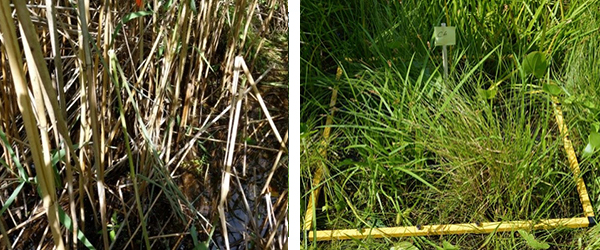
Highstead initiated a Phragmites australis control plan in 2012 to remove and prevent the reinvasion of the invasive common reed to improve the scenic viewshed and promote a more diverse, native flora around its pond. Four herbicide application treatments were initiated in winter 2013 and repeated in subsequent years. Vegetation monitoring began in the summer of 2012 and was repeated in 2013, 2014, and 2017.
Key Results:
- 98% of Phragmites stems were removed after 4 years
- Diversity of woody and herbaceous plants increased over time
- Both native and non-native plant species richness increased after removal of Phragmites
- The vegetation community and the viewshed of the pond are arguably more attractive today than before
Phragmites Research Answers Key Questions
What is the preferred method for removing the invasive Phragmites reed grass with herbicide? To what extent does herbicide treatment damage non-target vegetation? Do native plants increase in abundance and diversity following the invasive reed removal? Answers to these questions and others are reported in a 2020 article in the New England Botanical Club’s journal, Rhodora by Highstead’s Ed Faison, Geordie Elkins, Kathleen Kitka, and board chair David Foster.
The study, which took place at Highstead’s Pond between 2012 and 2017, reports the effectiveness of three different herbicide application methods (wand applicator, broadcast sprayer, hand wipe with glove) on the removal of Phragmites. The hand wipe technique was the most effective at removal and caused the least damage to other vegetation. Native (and other non-native) vegetation recovered quickly from initial damage from herbicide and became more diverse than before the invasive plant was removed. Still, as with any management project, there were inevitable tradeoffs – in this case the creation of new growing space for other non-native plants.